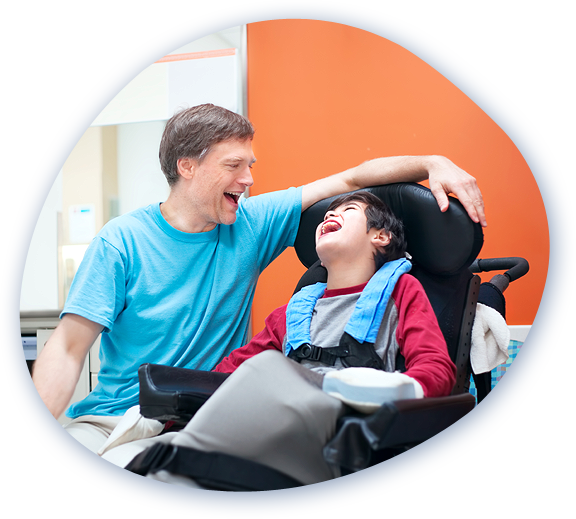(All levels, including Halo care)
Spinal Cord Injury (SCI)
There are many causes of pediatric spinal cord injury — trauma (falls, motor vehicle accident, sports injury, trampoline accident), infections, tumors, genetic disorders and birth-related injuries. The spinal cord extends down from the base of the brain and is comprised of nerves that carry messages between the brain and the rest of the body. A spinal cord injury (SCI) is acute damage to the spinal cord that results in partial or complete temporary or permanent loss of function below the site of injury. The extent of this loss depends upon the extent of the injury and impacts strength, sensation and other bodily functions.
Levels of SCI. There are four sections of the spinal cord that impact the level of SCI (cervical, thoracic, lumbar and sacral) — each indicating the specific vertebrae in the spinal column that has been damaged. A cervical SCI impacts the neck; thoracic impacts the upper back; lumbar impacts the lower back and sacral impacts the pelvis. Depending on the level and severity of the SCI, the treatment plan will be different.
HealthBridge SCI Care
At HealthBridge, a treatment plan will be developed for each child, unique to the specific injury and resulting physical limitations. The plan will take the child’s age, overall health, and treatment tolerance into consideration. Treatment will likely include a combination of many options, including: medical and medication management; rehabilitation therapy; surgery; ventilators; feeder tubes; bladder catheter; and assistive devices.
Halo Care. A halo is a specialized neck brace that surrounds the head and is held in place with pins in the outer skull. The brace is attached by a stiff vest by four bars. The halo immobilizes the patient and protects the cervical spine after surgery or trauma. The halo brace has been especially effective in children, allowing kids to move around while healing, while still receiving monitoring by experienced healthcare practitioners.

Pediatric Spinal Muscular Atrophy (SMA)
Spinal muscular atrophy is a rare progressive genetic disorder affecting motor neurons in the spinal cord. When the main SMN1 gene is missing or not working properly, a child’s body cannot produce adequate protein needed for motor neuron cell survival. As a result, a child will typically show symptoms of significant muscle weakness and difficulty breathing, swallowing, or speaking.
Types of SMA. Each type of SMA has varying levels of severity. Type 0 is the rarest and most severe and affects babies still in the womb. Life expectancy is very short for these infants. Type 1 is usually diagnosed in a child’s first six months of life and causes muscle weakness, problems sucking, swallowing and breathing. Type 2 is usually diagnosed between the ages of 6 months and 2 years. In addition to the symptoms shown with type 1, these children are prone to pneumonia and scoliosis (curvature of the spine). Type 3 affects children and young adults and limits their ability to stand and walk. They are at greater risk for falls, but typically do not have respiratory or developmental problems. Type 4 SMA is the mildest form of SMA. Children with Type 4 SMA usually begin experiencing symptoms in their 30s, but occasionally symptoms can develop while in their teens.
HealthBridge SMA Care
Because each case is different, our treatment team led by board-certified physicians will work with the family to create an individualized treatment plan. Treatment options could include: feeding support; surgery; specialized equipment and assistive devices (braces); physical, speech, respiratory and occupational therapy in state-of-the-art rehab gyms; respiratory support (ventilators and non-invasive systems such as bilevel positive airway pressure machine, or BiPAP, or airtight masks). Our highly-trained experts will work to make your child as comfortable as possible throughout this difficult journey.
Whether your child has suffered from a spinal cord injury or spinal muscular atrophy, at HealthBridge it’s our goal to provide your child every possible opportunity for recovery and the best quality of life. We do this through expert care, state-of-the-art equipment, and compassion for each child and his/her family.

